The American Mindset - The World in a Grain: The Story of Sand and How It Transformed Civilization
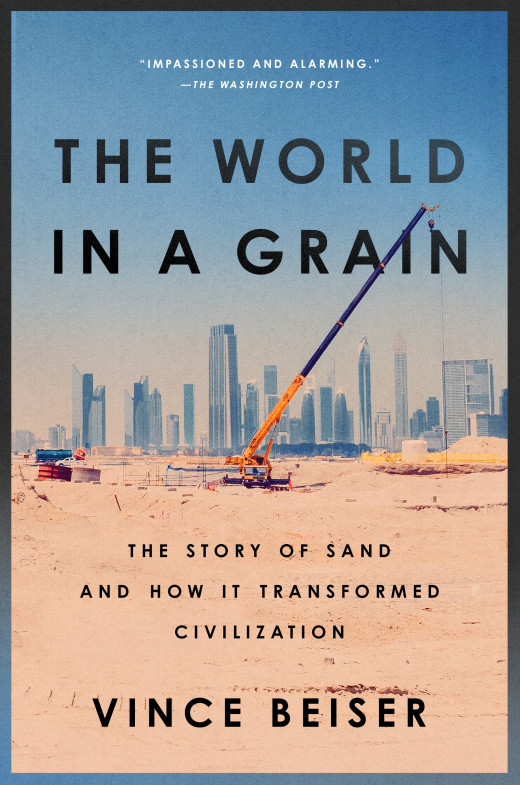
Sand doesn't get much thought, and seems to be an infinitely available substance which we could never dream of running out of. And yet as Vince Beiser relates in his book The World in a Grain: The Story of Sand and how it Transformed Civilization, nothing can be further from the truth: the amount of sand that is available to us and is useful is actually quite small indeed and we are using it up at an ever accelerating rate, while the vast deserts of the world such as the Sahara are covered with useless desert sand that is incapable of being used in our modern industrial life. Sand, however worthless and abundant it may seem, is actually both central to the development of our modern technological civilization, and is a valuable resource, one which is fought over with fortunes made and death garnered from its battles.
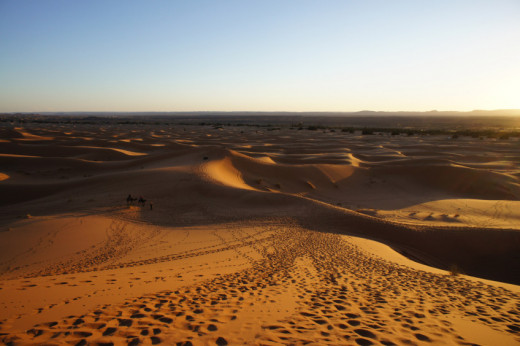
In the beginning, the importance of sand is laid out as "The Most Important Solid Substance on Earth", about the huge number of uses that sand go to, its recent development as such a crucial raw material, the penury we face of it, and the different types of sand. This has real world consequences in the depletion, shown by the environmental damage, and as the book relates in a story about activists trying to prevent illegal sand mining in India, often deadly ones with the murder of environmentalists and the complicity of state authorities.
"The Skeleton of Cities" as is titled the first chapter of Part 1, takes a closer look at how sand is used in concrete, which is the mainstay of our urban architecture. Concrete took over construction in cities starting from 1906, when it was praised for being much more flame and damage resistant than previous building materials during the San Francisco Earthquake, and permitting great flexibility in construction. Although concrete has been used for nearly two centuries, and even the Romans long ago made great usage of it, it was the development of reinforced concrete with steel and the publicity of San Francisco's fire which led to a massive proliferation of concrete as a vital tool in city construction.
It also paves our roads, the theme of "Paved with Good Intentions", about the development of the US highway network as cars began to explode in numbers on American roads, centering around the difficult car trips across the country by military men like Eisenhower or Carl Fisher, leading ultimately to the titanic construction projects of the Interstate and massive proliferation of global highways - both uniting the world together but also resulting in a massive explosion of cars, pollution, and huge usage of resources.
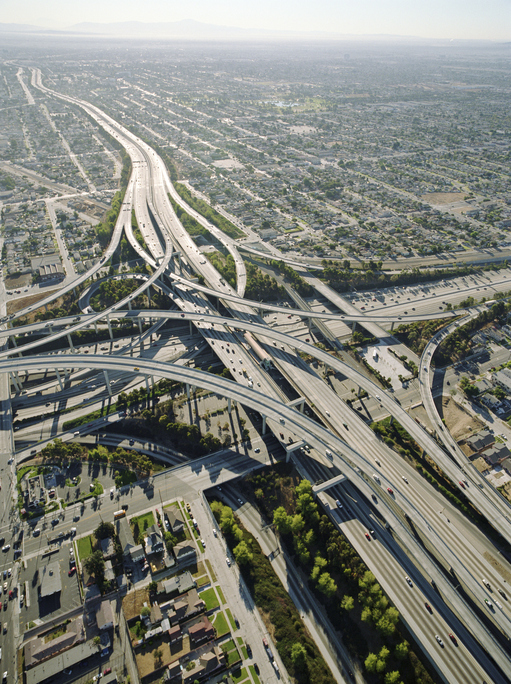
Taking a look at glass in "The Thing that Lets us See Everything," the story is a similar one: glass has been with us for millennia and highly valued, reliant upon specific types of pure quartz sands. It entered the industrial age thanks to Michael Owens, who invented an automatic glass blowing machine to make bottles on a truly industrial scale, followed by similar innovation in flat glass producing windows for houses, building, and cars. Fiberglass too joined this, for both construction and insulation, as well fiber-optics cables. Glass is in everything, and production is massive, and civilization is completely dependent on it.
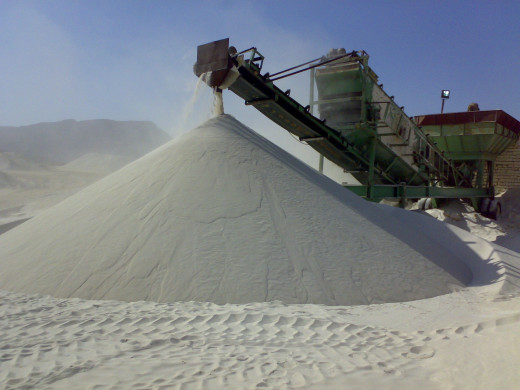
Part 2 with its first chapter "High Tech, High Purity", looks at sand and its modern, high tech uses, with ultra-pure silica sands being used to make even purer silica for computing, through extremely complicated and precise refining processes. Central to this production is Spruce Pine in North Carolina, a poor region, mined by highly secretive companies, whose sand lies at the heart of the entire technological world we have constructed.
Sand finds use in dirtier applications, as shown in "Fracking Facilitator." Sand is a vital tool for fracking, a process of injecting water and sand into oil fields to enable oil to be extracted from otherwise inaccessible rock, and it requires high quality quartz sand, and lots of it - up to 25,000 tons per well. Much of the sand for the oil boom in South Dakota comes from Wisconsin, and the book paints a tableau of a region where many are outraged about the vast environmental degradation and damage to their health that comes from it - but which also has benefited many farmers and made many wealthy.
An interlude talks about some various miscellaneous uses for sand, from sand baths, to forensic evidence, to facials, to artwork.
Sand is used not just under the land as well, but on its edge, as shown in "Miami Beach-less". Sand is used in massive amounts to replenish beaches, and there is a massive industry of illegal mining in some beaches to provide for sand for other ones, as well as huge declines in sand naturally available for beaches due to dams and human transformations of the environment. Sand is instrumental in being utilized by humanity in creating our vacation ideal, the beach - so that in the modern day it is far from being natural, but has been created by humanity, with Miami, the chosen example, being a massive engineering project. Dredging sand for these projects results in massive environmental destruction and similarly massive expenses, and as available sand supplies dwindle, this will only get worse.
A brief interlude notes that there are an estimate 7,500,000,000,000,000,000 grains of sand in the world's beaches.
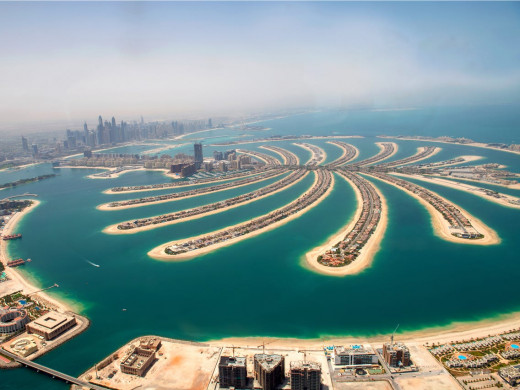
Of course, in the modern world our engineering projects much dwarf anything involved in Miami, most dramatically demonstrated by the huge land reclamation projects present in Dubai, the topic of "Man-Made Lands." Here, huge amounts of sand is utilized to build huge artificial islands for the super-wealthy, such as "The World", with a huge sand map of the world, to house actual "countries", and a huge island project in the shape of a palm tree. Both of these rely on vast transfusions of dredged sand, from the sea - desert sand not being suitable for construction purposes. Although not on the same scale, land reclamation has also been used on a huge scale in Asian countries and other countries around the Persian Gulf. It also has increasing geopolitical ramifications, being used by China for building up island fortifications in the South Chinese Sea.
A brief interlude talks about Ralph Bagnold, a British army officer who studied the Sahara desert sands, then fought in long range raiding units in WW2 in North Africa, and whose research into sand movements continues to be used today.
Of course, all of these chapters talk about using sand, but what about fighting against it? "Desert Sand" is about the struggle by China to attempt to confine the expanding desertification of Northern China, which has had mixed results in massive planting of trees to attempt to push back the desert - and which has made many people tremendously wealthy along the way.
While the United States might have been the first country to make large-scale usage of concrete, China has with many other things massively surpassed the United States, as shown in "Concrete Conquers the World." Huge amounts of sand is pulled from the Yangtze and from Poyang Lake, to produce the concrete for Shanghai. China uses incredible amounts of concrete, fueling its massive urbanization. While this has brought China to dizzying new heights of material prosperity, and concrete has brought important importants to quality of life, it has also been at vast environmental consequences, turned cities into heat sinks with major health risks, and destroyed traditional ways of housing. Concrete also faces severe problems for long-term survivability in light of wear and tear, rust for its rebar used in reinforced concrete, and substandard concrete risks collapse which can kill hundreds of people. Dams are left in poor repair, and bridges run the risk of collapsing. We do not do a good job of repairing our infrastructure and buildings.
The final chapter, "Beyond Sand" aims to look at what alternatives exist to our current paradigm, about reforming the practices of sand mining, an increasingly expensive practice which relies upon corruption and international environmental degradation to secure the sand needed for our construction. Scientists hope to improve concrete quality and its resistance to damage, as well as to reduce its environmental impact, but the ultimate problem is that we have to find a way to reduce our massive consumption of sand.
Sand is a material which can have an almost endless list of uses, and thus an almost infinitely long book written about it. Beiser's book isn't an extremely long book - it is relatively short, simple to read, written like a piece of journalism - not that surprising, since Beiser seems to have worked for NPR before.This is an important part of its strength, since it is able to sculpt an easily understood and convincing narrative of sand as a fundamental centerpiece of modern civilization, choosing to cover the most important, or at least the most sexy, developments with sand - building our cities through concrete, fracking, usage in computers and glass, and land reclamation. The reader won't be bored: there are plenty of intermissions of interesting facts, and the book's style is easy going, easy to understand. It might be pop history - but it is good pop history.
It isn't necessary for a book to be balanced about a subject, but Beiser's volume does a good job of looking at both what the positive benefits of sand are, or at least what it enables, and so too what the drawbacks are. This is particularly true in his chapter on fracking sand, where it both shows the real and genuine environmental movements that have sprouted up in Minnesota to oppose the massive mining of sand for oil fracking, but at the same time how some farmers in the region have benefited from it, from being able to sell their land to make a profit. It is rarely the case that capitalism is purely losers, or purely winners - there are those who do enrich themselves, and those who are harmed.
This focus on the lives of individuals is part of what makes the book readable. It is above all else concerned with the lives of people - with farmers, miners, inventors, industrial workers, financiers, scientists. The Story of Sand is not at all very complicated in its reading - it doesn't attempt to weave very detailed links between its sections, and it is content to paint them and let them add up to a general picture. The author's journalist roots are clear in the way that the people talk, but along with the simple writing style it makes the book easy to read and enjoyable - it feels grounded, and pleasant. If sometimes, it reads strangely due to the way the author phrases it - comparing sand to soldiers, militarizing even the construction of cities with the idea of the deployment of vast legions to build our modern civilization.
The World in a Grain is fascinating for what sort of proposals it has to fix the problems it outlines in the book, if not necessarily these proposals in of themselves commanding any particular merit: it is these which give it such an American appearance to it in how it perceives changing the world. Its recommendations are simple - that we need to reduce the amount that we consume, in order to ensure environmental stability. How to achieve this? Through the proliferation of the apps of the "sharing economy," Uber and Airbnb, which the author touts as offering more efficiency. It makes for a painfully anticlimatic close to the book, one which doesn't try to seriously change anything, and which vaunts ideas which are clearly impractical on a massive scale: replacing cars with uber is an obvious economic infeasibility since it simply implies a massive class of taxi drivers being created, while Airbnb has worsened, not improved, housing shortages across the world, by hurting regular renters. American books on technology, or simply problems in general of societal nature, will often go for the same idea: Americans have such a massive faith in that science and capitalism will liberate them from their problems, so that global warming and war and poverty and revolutionary forces can all be tamed by them. This is married to avoiding the negative consequences that this salvation itself carries with it - the book notes on its chapter on fracking sands that it would be better if we replaced the oil industry with solar and wind power, but what about the massive amounts of high quality sand needed for photovoltaics?
Sometimes American optimism is right after all - but The World in a Grain is saddeningly anti-climatic and unrealistic in its final pages about ways to fix the over-consumption of resources. It is better in its main body, with ideas about better technology in concrete, but it lacks the panache to muddle its way out of the contradiction it created - that the benefits of modern civilization cannot be abandoned, and yet at the same time that these benefits come at the cost of too many inefficiently used resources. In the end, it gets stuck in sand.
© 2020 Ryan C Thomas









